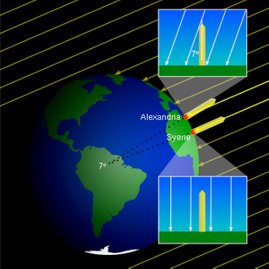Kepler-science.nl
The English pages can be found in the second row of the menu
De eerste rij knoppen in het menu is voor de Nederlandse pagina's
Earth and Sun
We see sun, moon, planets and stars rise in the East (roughly), climb higher towards the South and descent and set roughly in the West. In the North sky we only see stars, which in their daily movement seem to revolve around the North Star (Polaris). Does the Sun orbit the Earth or does the Earth revolve around it's axis? This important question for scientists played a big role in the development of science. By the way: did people in the Middle ages really believe the Earth was flat?
The Sun
In summer the sun rises more to the North, in winter more to the South. Look at the Sundial and the two gnomon shadow patterns below:
- The time of sunrise is connected to the direction
- Length of day (arrow circle) and shadow pattern depend on season and location: the closer to the poles the more it varies through the year
The daily and yearly movement of the Sun can be explained as follows:
- The Earth revolving daily around the Sun (not seriously considered)
- The Sun revolving daily around the Earth, spiraling up and down: Ptolemy and Tycho
- The Earth revolving around its axis and orbiting the Sun (with a tilted axis): Copernicus.
The stars
Stars show the same daily movement as the Sun but a star day is about 4 minutes shorter than a solar day. This is explained as follows:
- Stars revolve around the Earth daily (but without the spiraling up and down): Ptolemy and Tycho
- Stars have a fixed position: the Earth revolves around its axis and travels through space to orbit the Sun: Copernicus
To prove Copernicus right parallax of stars had to be shown (Bessel was the first to do that in 1838) - which is very small, the nearest star being 4 light years away. See for an explanation of parallax the page Universe.
Above is shown how Erathostenes determined the circumference of the Earth (zie ook link 2)
Links and Downloads:
- Download the SCIENCE star map
- On how Erathosthenes measured the size of the Earth
- A nicer one on Eratosthenes (use password: circumference99)
- A short article about Inventing the flat Earth
- Falling flat by Danny Faulkner is a refutation of Flat Earth claims
- Go to sun and moon scope for simulations, like for heliocentric and geocentric models, length of day and heigth of the sun on different times and places and the Rosetta mission.
- Download Stellarium: a freeware planetarium programme
- Sites of the NASA: www.jpl.nasa.gov and www.nasa.gov.
- The European Space Agency: ESA
- An elaborate BBC-site on science&enviroenment
- An article in the Guardian about travelling to Mars
- Wikipedia on parallax
- Watch the video about Foucault's pendulum








